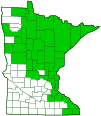pipsissewa
(Chimaphila umbellata ssp. cisatlantica)
Conservation • Description • Habitat • Ecology • Use • Distribution • Taxonomy
Conservation Status |
|
|||||||
| IUCN Red List | not listed |
|||||||
| NatureServe | N5 - Secure SNR - Unranked |
|||||||
| Minnesota | not listed |
|||||||
Description |
||
Pipsissewa is a low, slow growing, evergreen, dwarf shrub. It is native to North America from Nova Scotia south to South Carolina and west to Minnesota. In Minnesota it is common in the northeast and central regions, uncommon in the metro and southeast regions, and absent from the southwest region and the western counties. It requires rich, undisturbed soil covered by a layer of leaves or needles. Logging or even compressing the soil by walking on it are threats to this plant. Pipsissewa is an erect, perennial dwarf shrub (subshrub) that rises on one or a few stems from an underground, creeping, horizontal stem (rhizome). It can be 4″ to 18″ (10 to 45 cm) tall but it is usually no more than 9″ (23 cm) in hight in Minnesota. It often forms small, sometimes dense and mat-like colonies. The stems are erect and hairless. They usually have 2 to 4 short, spreading branches. The branches elongate each year. After several years, they recline on the ground and produce roots where a node touches the ground. The leaves are arranged mostly in whorls of 3 to 8, sometimes as opposite pairs. They are on 1⁄16″ to ½″ (2 to 12 mm) long leaf stalks (petioles). The petioles are hairless and are grooved above. The leaf blade is inversely lance-shaped to narrowly inversely egg-shaped (widest near the base), sometimes narrowly elliptic (widest in the middle), 1½″ to 3″ (38 to 80 mm) long, and 5⁄16″ to 1 1⁄16″ (8 to 27 mm) wide. They are narrowly angled or tapered at the base and narrowly or broadly angled at the tip. The upper surface is dark green, shiny, and hairless. The lower surface is pale green, brownish-green or copperish-green, dull, and hairless. The midvein is depressed on the upper surface, raised on the lower surface. The margins are coarsely toothed, especially from the middle to the tip of the blade, with sharp, forward pointing teeth. The inflorescence is a branched cluster (corymb) of 3 to 7 flowers at the end of an upright, 1½″ to 4″ (4 to 10 cm) long inflorescence stalk (peduncle). The peduncle is leafless and is covered with tiny bumps (pappilose). It rises well above the uppermost leaves. Each flower droops downward at the end of a ⅝″ to 1⅜″ (17 to 35 mm) long flower stalk (pedicel). The flowers are saucer shaped and ⅜″ to ½″ in diameter. There are 5 outer floral leaves (sepals), 5 petals, 10 stamens, and 1 style. The sepals (together the calyx) are broadly egg-shaped, 1⁄32″to ⅛″ (1 to 3 mm) long, and 1⁄16″to ⅛″ (2 to 3 mm) wide. They are green, yellowish-green, or reddish-green with papery white margins. The petals are broadly egg-shaped or inversely egg-shaped, ⅛″ to ½″ (4 to 12 mm) long, and ⅛″ to 5⁄16″ (4 to 8 mm) wide. They are white tinged with pink or rose. The stamens have white, 3⁄16″ to ¼″ (5 to 7 mm) long stalks (filaments), and pink to brownish-pink anthers. The ovary is green and depressed globe-shaped. The style is very short, less than 1⁄32″ (1 mm) long. It is capped by a green, ⅛″ to 3⁄16″ wide stigma. The fruit is a flattened globe-shaped, ⅛″ to ¼″ (4 to 6 mm) long, ¼″ to ⅜″ (6 to 10 mm) in diameter capsule. The fruits are held erect and persist into the following spring. |
||
Height |
||
4″ to 9″ |
||
Flower Color |
||
White tinged with pink or rose |
||
Similar Species |
||
Habitat |
||
Dry. Coniferous and deciduous forests. Partial sun. Sandy soil. |
||
Ecology |
||
Flowering |
||
Early to late July |
||
Pests and Diseases |
||
|
||
Use |
||
|
||
Distribution |
||||
|
Sources |
|||
| 5/25/2023 | ||||
Nativity |
||||
Native |
||||
Occurrence |
||||
Common |
||||
Taxonomy |
|||
| Kingdom | Plantae (Plants) | ||
| Division | Tracheophyta (Vascular Plants) | ||
| Subdivision | Spermatophytina (Seed Plants) | ||
| Class | Magnoliopsida (Dicots) | ||
Order |
Ericales (heathers, balsams, primroses, and allies) | ||
Family |
Ericaceae (heath) | ||
| Subfamily | Monotropoideae | ||
| Tribe | Pyroleae | ||
Genus |
Chimaphila (wintergreens) | ||
| Species | Chimaphila umbellata (pipsissewa) | ||
Subfamily Subspecies |
|||
Subordinate Taxa |
|||
Synonyms |
|||
Chimaphila corymbosa Chimaphila umbellata ssp. umbellata Chimaphila umbellata var. cisatlantica |
|||
Common Names |
|||
pipsissewa prince’s pine umbellate wintergreen |
|||
Glossary
Calyx
The group of outer floral leaves (sepals) below the petals, occasionally forming a tube. Plural: calyces.
Corymb
A flat-topped or convex inflorescence in which the stalked flowers grow upward from various points on the main stem to approximately the same horizontal plane. The outer flowers open first.
Elliptic
Narrowly oval, broadest at the middle, narrower at both ends, with the ends being equal.
Filament
On plants: The thread-like stalk of a stamen which supports the anther. On Lepidoptera: One of a pair of long, thin, fleshy extensions extending from the thorax, and sometimes also from the abdomen, of a caterpillar.
Node
The small swelling of the stem from which one or more leaves, branches, or buds originate.
Papilla
On plants: A tiny, rounded, nipple-like projection on the surface of a leaf or petal. On mushrooms: A small, raised, sharply pointed projection on the cap above the point of attachment with the stalk.
Pedicel
On plants: the stalk of a single flower in a cluster of flowers. On insects: the second segment of the antennae. On Hymenoptera and Araneae: the narrow stalk connecting the thorax to the abdomen: the preferred term is petiole.
Peduncle
In angiosperms, the stalk of a single flower or a flower cluster; in club mosses, the stalk of a strobilus or a group of strobili.
Petiole
On plants: The stalk of a leaf blade or a compound leaf that attaches it to the stem. On ants and wasps: The constricted first one or two segments of the rear part of the body.
Rhizome
A horizontal, usually underground stem. It serves as a reproductive structure, producing roots below and shoots above at the nodes.
Sepal
An outer floral leaf, usually green but sometimes colored, at the base of a flower.
Spreading
Extending nearly horizontal.
Whorl
A ring-like arrangement of similar parts arising from a common point
Visitor Photos |
|||||
Share your photo of this plant. |
|||||
| This button not working for you? Simply email us at info@MinnesotaSeasons.com. Attach one or more photos and, if you like, a caption. |
|||||
Luciearl |
|||||
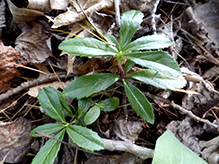 |
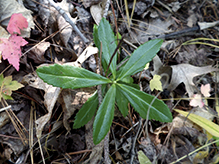 |
||||
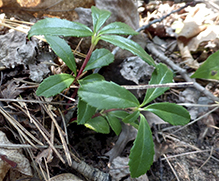 |
|||||
MinnesotaSeasons.com Photos |
|||||
Plant |
|||||
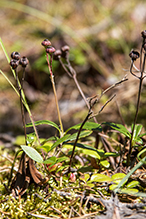 |
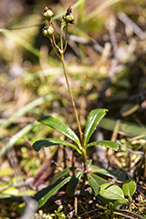 |
||||
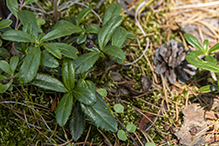 |
|||||
Leaves |
|||||
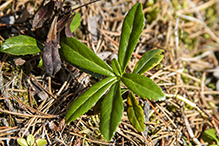 |
|||||
Infructescence |
|||||
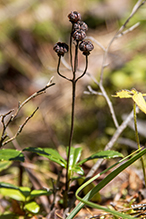 |
|||||

Slideshows |
||

Visitor Videos |
|||
Share your video of this plant. |
|||
| This button not working for you? Simply email us at info@MinnesotaSeasons.com. Attach a video, a YouTube link, or a cloud storage link. |
|||
Other Videos |
|||
| Pipsissewa (Chimaphila umbellata) Robin Ackeret |
|||
About
Sep 2, 2011 This study is based almost entirely on the Pipsissewa plant,((Pepsi?)) also known as Chimaphila umbellata. As expected found around the moss, Oregon grape and Salal in a moister than average locale around 4,000 feet in the Oregon Cascade Mountains. There was a lot of medium level flowers and plants including red Huckleberries. This ferny slope will soon be host to Golden Chanterelle mushrooms, Lobster of the Woods , and large Cauliflower mushrooms. Don't worry my friends, I plan on finding those and filming them as well Peace, Robin!!!!!! |
|||

Created: 10/25/2020
Last Updated:
